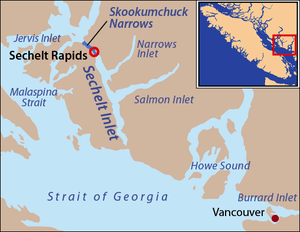Sechelt Inlet
Coordinates: 49°38′0″N 123°50′30″W / 49.63333°N 123.84167°W

Sechelt Inlet is one of the principal inlets of the British Columbia Coast and the third of such inlets north from the 49th parallel north, the first of which is Burrard Inlet, Vancouver's harbour. The inlet is significant in that it almost makes an island of what is instead the Sechelt Peninsula, whose isthmus is at the town of Sechelt at the head of the inlet. The isthmus is less than 1.2 kilometres (0.75 mi) in distance.
Another significant thing about Sechelt Inlet is the famous saltwater rapid (Sechelt Rapids) as it enters, Skookumchuck Narrows, which rages with near waterfall-like fury during tide changes. Other fjords on the British Columbia Coast have similar rapids, also called skookumchucks (strong waters in the Chinook Jargon, the old coastal trade language), which like Sechelt Inlet are caused by the typical shallows near the mouth of a fjord as the volume of water inside the fjord's depths tries to pour out to, or in from, the more open waters beyond. In Sechelt Inlet's case, the Skookumchuck Narrows are exactly as its name describes - narrow - forcing the water to an even greater torrent than is typical elsewhere.
Sechelt Inlet has two side-inlets, Salmon Inlet, which begins at a small power dam at the mouth of the Clowhom River and is about 23 km in length, and Narrows Inlet, which starts at the mouth of the Tzoonie River and includes the Tzoonie Narrows. The latter is about 15 kilometres (9.3 mi) in length and emerges on the main inlet just inside the inner mouth of the Skookumchuck Narrows.
From early April to late September 2007, the inlet was a habitat for over 200 Pacific white-sided dolphin. These social mammals seemed to enjoy seeking the attention of their human observers.